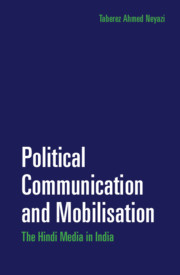Book contents
- Frontmatter
- Dedication
- Contents
- List of Figures, Tables and Maps
- Preface
- Acknowledgements
- Chapter 1 Introduction: Political Communication and Mobilisation in India
- Chapter 2 Under Colonial Rule: Mobilisation in the Hindi and English Press
- Chapter 3 Media and Mobilisation in Independent India
- Chapter 4 Localisation, Grassroots Mobilisation and Hindi News Media
- Chapter 5 Political Economy of the Hindi Press
- Chapter 6 The Hybrid Media System, Anti-corruption Movement and Political Mobilisation
- Chapter 7 Agenda-setting and Mobilisation in a Hybrid Media Environment
- Chapter 8 Conclusion: Politics, Power and Mobilisation in Digital India
- Bibliography
- Index
Chapter 1 - Introduction: Political Communication and Mobilisation in India
Published online by Cambridge University Press: 17 August 2019
- Frontmatter
- Dedication
- Contents
- List of Figures, Tables and Maps
- Preface
- Acknowledgements
- Chapter 1 Introduction: Political Communication and Mobilisation in India
- Chapter 2 Under Colonial Rule: Mobilisation in the Hindi and English Press
- Chapter 3 Media and Mobilisation in Independent India
- Chapter 4 Localisation, Grassroots Mobilisation and Hindi News Media
- Chapter 5 Political Economy of the Hindi Press
- Chapter 6 The Hybrid Media System, Anti-corruption Movement and Political Mobilisation
- Chapter 7 Agenda-setting and Mobilisation in a Hybrid Media Environment
- Chapter 8 Conclusion: Politics, Power and Mobilisation in Digital India
- Bibliography
- Index
Summary
Any generalisation about the Indian media is problematic because there are diverse media systems within the country. The Hindi language media has the widest circulation, reaching almost 40 per cent of India's total population, and the Hindispeaking population accounts for over 40 per cent of the national population and is regionally concentrated in the northern and central parts of India. The success of the Hindi media should not be compared with other vernacular language media such as Tamil and Bengali, because the Hindi language press enjoyed state support both during the colonial period and in newly independent India that helped the Hindi media attain privileged status. Hindi, together with other vernacular media, has a far wider reach than the indigenous English media, catering to both elite and popular constituencies, and is a politically significant player. While the English language media is often described as the ‘national media’, its reach is limited to a much smaller percentage of the population – the English-speaking elites and the middle class. The process of political communication is, therefore, more nuanced because India's news media market is more complex and diverse than in most other countries.
Moreover, the complexities associated with the size of the political economy of India requires special focus on how ethnic, religious and sectarian diversity impacts media markets and media systems, political campaigning, protest movements and grassroots mobilisation. This is largely because of the many languages in India and the existence of numerous regional and local media systems in vernacular languages. Despite the fact that similar large economic forces operate in the globalising Indian market place, there are still stark sociocultural differences in the media systems of different states in India and, thus, many media systems exist within one country. At the same time, the process of political communication is affected by the gap between urban and rural, as well as inter- and intra-state differences on various development indicators such as literacy, poverty, urbanisation and media availability. In contrast to many western democracies that have experienced a largely linear process of media evolution with the rise of print followed by radio then television and more recently the cell phone and the internet, India has witnessed tremendous growth across all media simultaneously over the past decade.
- Type
- Chapter
- Information
- Political Communication and MobilisationThe Hindi Media in India, pp. 1 - 27Publisher: Cambridge University PressPrint publication year: 2017



